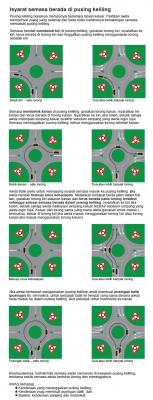(this is new zealand publication, but it should be the same for almost all commonwealth country, including ours)
Let's look at a number of examples of giving way which can help you determine what to do at many kinds of intersections in New Zealand (and around the world). If you've been confused about the rules before, these simple examples will help you learn them easily.
The basic give way rules are:
>Give way to your right at roundabouts
>Give way to vehicles coming from straight ahead if you are turning right
>Give way to vehicles turning left if you are turning right
>Give way to all vehicles on the top of a T-intersection if you are on the bottom of the T
>A driveway is treated like an uncontrolled intersection
>If you deviate from the centre line, generally you have to give way
>At a stop sign, you have the least priority and all other vehicles have the right of way before you, unless they are at stop signs, too, in which case the give way rules apply
>A police officer's directions overrule any give way or stop signs.
Intersection examples
In all examples, let's look at it from the point of view of you driving the blue car.

You are turning out of an uncontrolled intersection and must give way to the red car coming from the right. If this was a controlled intersection then you'd have to either stop at a stop sign or wait at a give way sign until it was safe to go.

You are driving straight ahead in the blue car across the top of the T-intersection. The red car has to give way to you because it is turning right across your path.

While the general rule is give way to the right at an uncontrolled intersection, that only applies at a crossroads. In this case, you are on the bottom of the T, and the red car has right of way as it is coming across the top of the T-junction. At a controlled intersection you would either be waiting at a stop sign or a give way sign.

The red car is coming from straight ahead and you are turning right therefore you must let it past before you can turn.

Even though the red car is on the right, it is waiting at a give way sign and you are passing straight through the junction. Therefore you have the right of way. The same would apply if it was waiting at a stop sign.

You are turning left and the red car is turning right and would have to cross your path. This used to be the rule in New Zealand until it was changed in 2012. Now, you have the right of way and can turn before the red car.

You are turning right and so is the red car. Which one gives way? The red car is on the bottom of the T-intersection (imagine rotating the picture 90 degrees clockwise). You are driving on the top of the T therefore you can go.

You are turning left and there's a red car coming from your right along the road. You have to wait because you are on the bottom of the T.

This is a tricky one. It's an uncontrolled intersection and both of you are travelling straight ahead. Who has to give way? The rules are that you give way to the right when there are no other controls like a stop sign, therefore the red car must stop and wait for you.

Remember our stop sign rule. At an uncontrolled intersection or one where you were both waiting at a give way sign, you would have right of way. However, you are waiting at a stop sign and that means that the red car has priority, even though it's turning across in front of you.
This post has been edited by kurangak: Dec 20 2016, 08:42 PM


 Dec 10 2016, 12:20 PM, updated 10y ago
Dec 10 2016, 12:20 PM, updated 10y ago
 Quote
Quote






















 0.0200sec
0.0200sec
 1.20
1.20
 6 queries
6 queries
 GZIP Disabled
GZIP Disabled